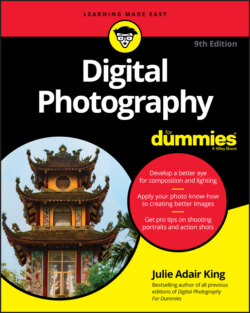Читать книгу Digital Photography For Dummies - King Julie Adair, Julie Adair King - Страница 21
Interchangeable-lens cameras
ОглавлениеCameras in this category consist of two components: a camera body, which contains the guts of the picture-taking system, and a lens, which you attach to a mount on the front of the body.
What does this flexibility give you? Well, as of yet, no one has invented a single lens that's perfectly suited to capturing the entire range of subjects photographers may want to shoot. A lens designed to produce an extreme close-up, for example, has different optical qualities than one engineered to capture a faraway subject. Ergo ipso facto, we have the interchangeable-lens camera, which enables you to use whatever lens your subject demands.
Within this category, you find the following types of cameras:
dSLR (digital single-lens reflex): For a look at this type of camera, refer to Figure 1-1; the far-left and far-right models are both dSLRs. About the name: The d in dSLR represents digital, distinguishing a digital SLR from film models, which have been around for a long time. SLR stands for single-lens reflex and refers to the viewfinder technology used in this type of camera. The name stems from the fact that the SLR viewfinder involves a series of mirrors that reflect (reflex) the light coming through the lens to the viewfinder display.Although dSLRs were once large, heavy, and complicated, manufacturers now also offer models geared to novice photographers as well as advanced shooters. High-end dSLRs still remain fairly large, but entry-level and intermediate models are available in significantly reduced sizes. The smaller of the two dSLRs in Figure 1-1 isn't much wider than the compact, fixed-lens model or, for that matter, the smartphone.
Mirrorless cameras: With this type of camera, the mirror-based viewfinder system is gone — thus, it's mirrorless. Taking out that mirror assembly enables mirrorless camera bodies to be smaller and lighter than dSLRs. Figure 1-7 shows a top view of a mirrorless model next to a small dSLR for comparison. I show both models without a lens attached so that you can get a better idea of how the mirrorless design affects the size of the camera body. However, not all mirrorless camera bodies are as small as the one in the figure. In fact, some pro mirrorless bodies are a bit larger and heavier than the smallest dSLRs. Of course, the size of the lens you put on the body determines the overall bulk and weight of both types of cameras.FIGURE 1-7: Although it’s not always the case, a mirrorless camera body (left) is usually less bulky than even a small dSLR (right). Some mirrorless models do away with the viewfinder entirely; you compose the image using the monitor on the camera back. Others, such as the one featured in Figure 1-7, incorporate or enable you to attach an electronic viewfinder (EVF), which provides the convenience of a viewfinder without taking up as much space as an optical viewfinder, which is the type used in a dSLR viewfinder. The section “Viewfinder: Optical or electronic,” later in this chapter, has more details. Today, the hot commodity in the pro photography arena is a full-frame mirrorless camera. You get the image-quality and lens coverage benefits of a full-frame sensor in the smaller body afforded by the mirrorless design, all of which sounds good. However, these models are expensive; expect to spend $1,000 or more just for the body. And you can’t use your existing dSLR lenses without an adapter, which negates some of the size and weight benefits of a mirrorless system. If you want to ditch the adapter, you’ll have to buy new lenses specially designed for the mirrorless body you pick. Personally, I don’t have that kind of cash on hand, but as with all technology, prices tend to drop as time goes by, so … a girl can dream, can’t she?
Rangefinders: A less-common variety of interchangeable-lens camera, rangefinders look a lot like mirrorless models, but work quite differently. Traditional rangefinders use a different focusing system than other cameras. The viewfinder displays two views of your subject, and you determine the focusing distance, or range, by turning a ring on the lens until the two images align. Most rangefinders offer only manual focusing, although a few do also provide some autofocusing options. Leica is the best-known manufacturer of rangefinder digital cameras.
